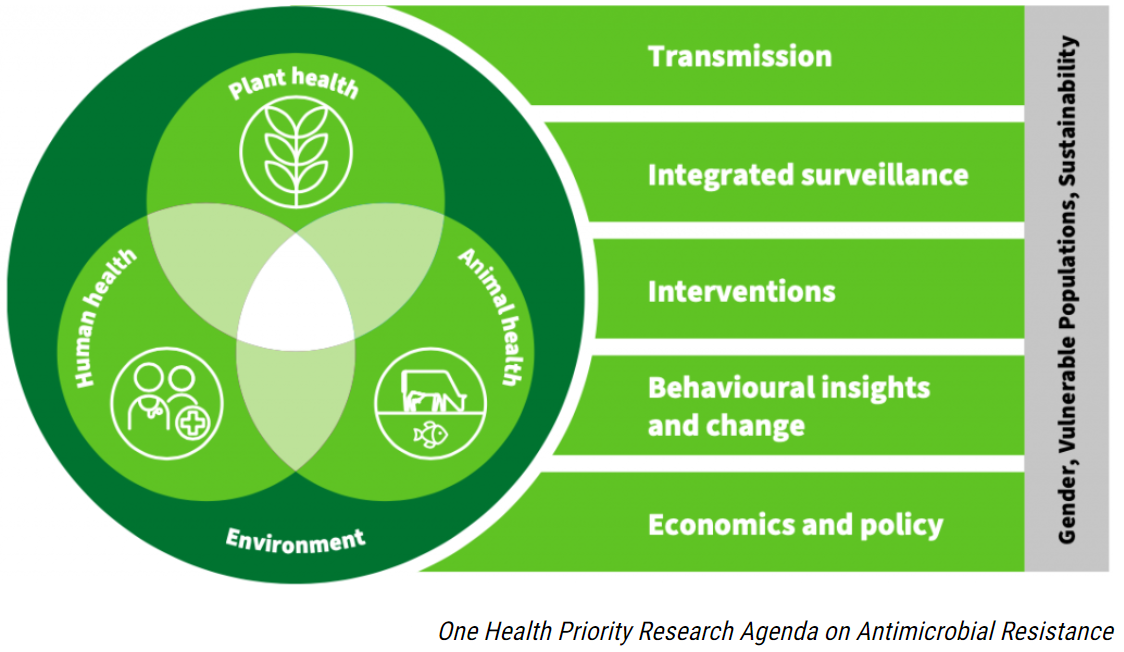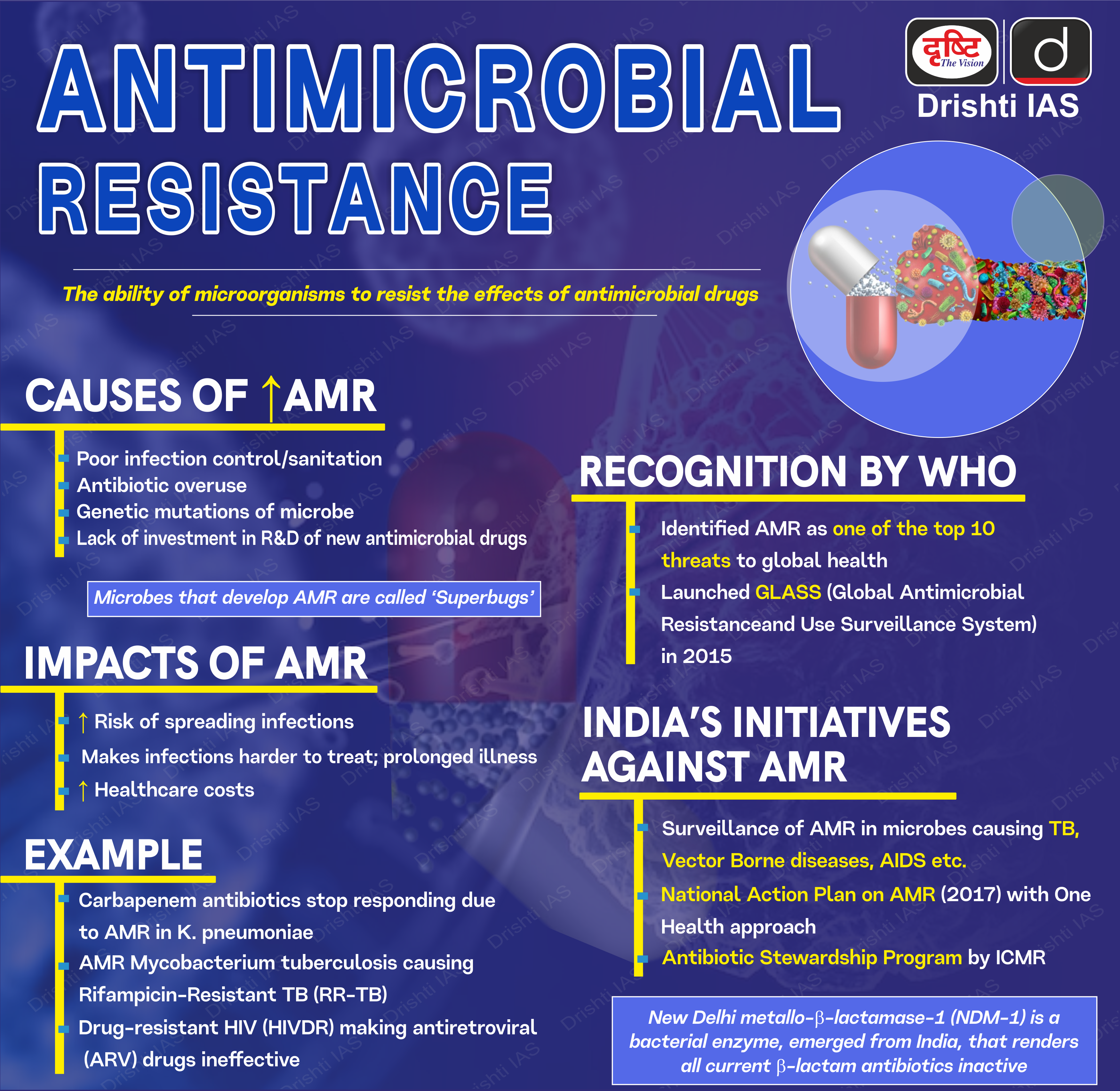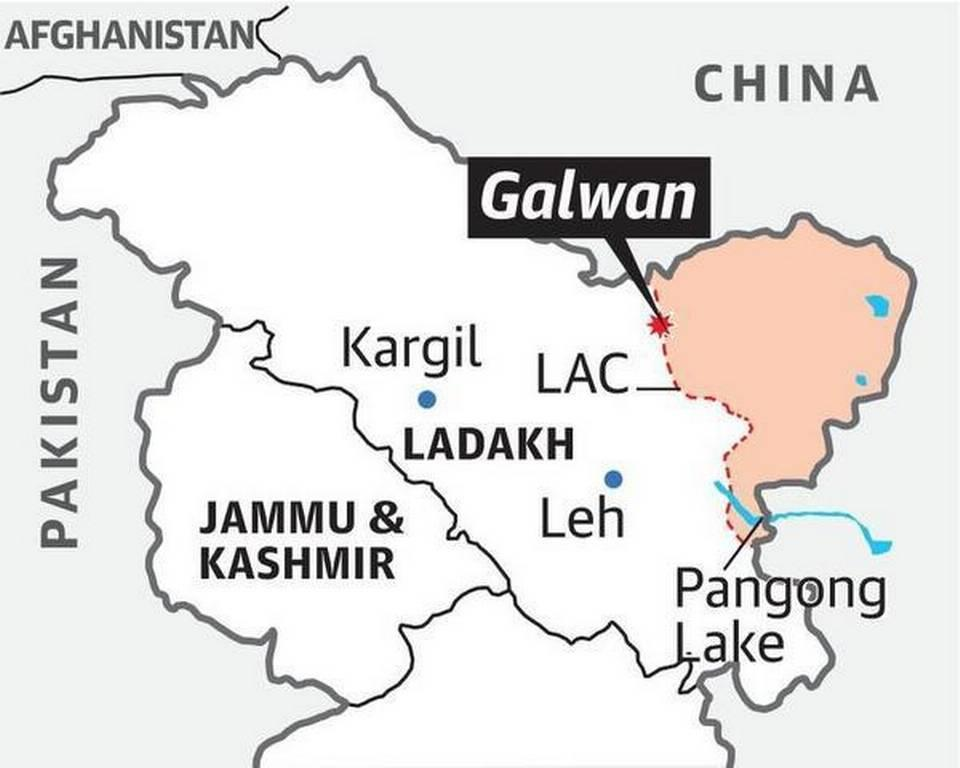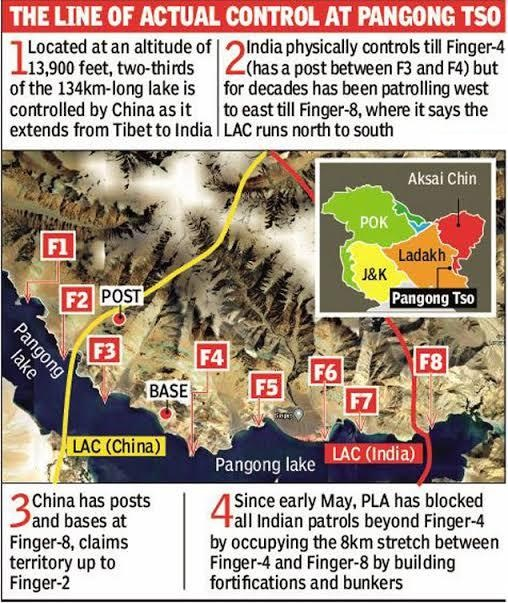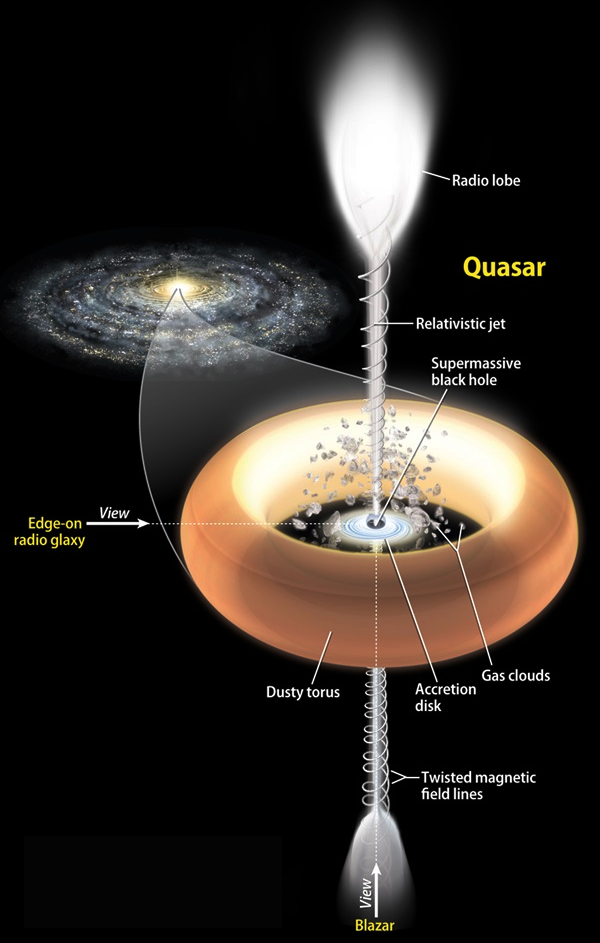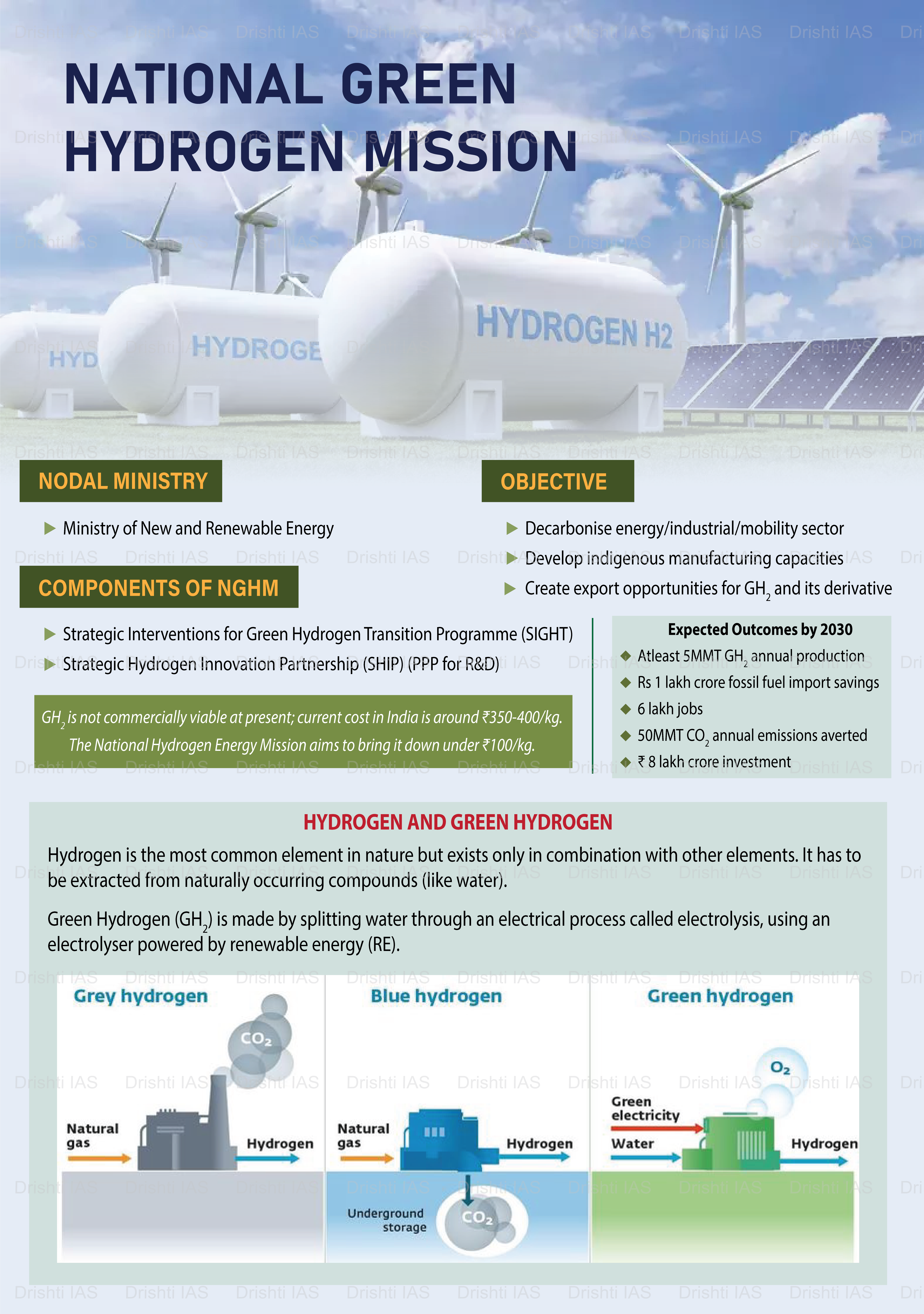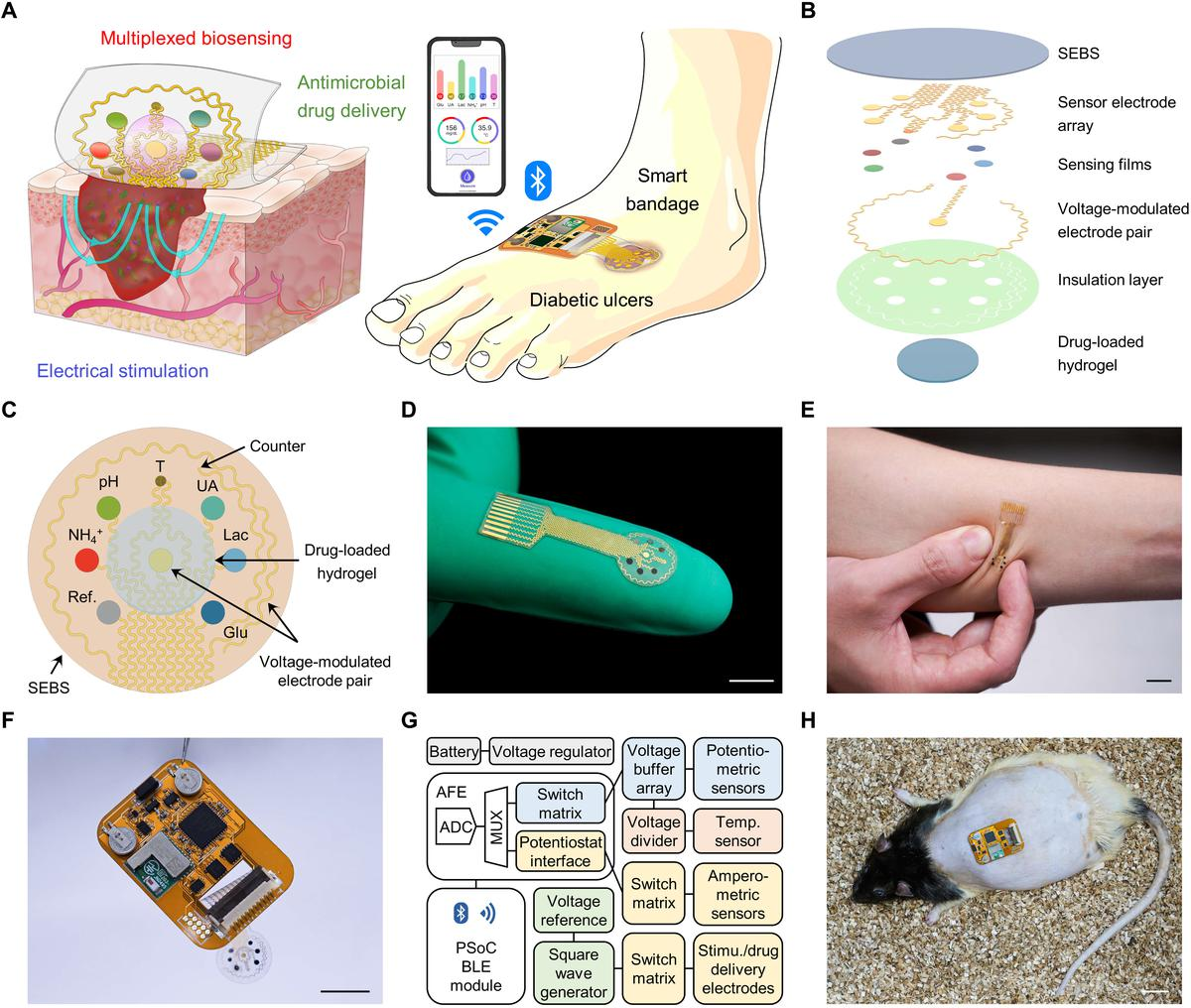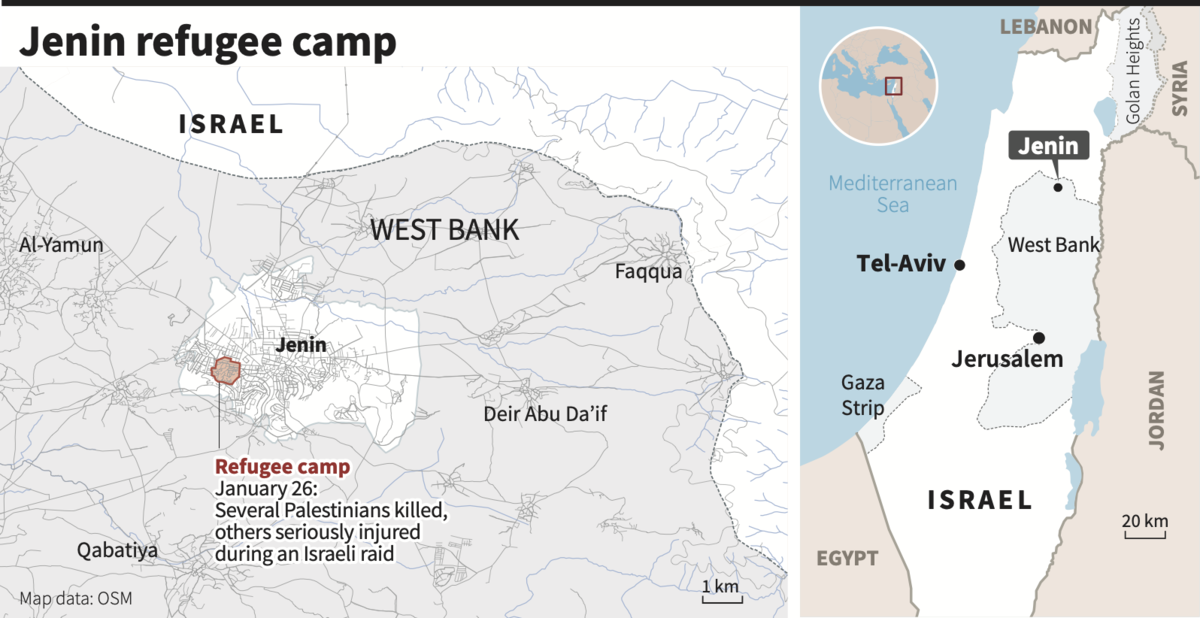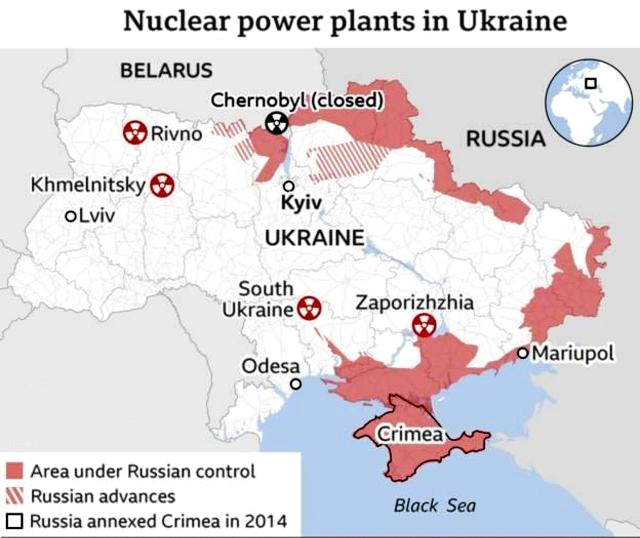Science & Technology
Antimicrobial Resistance and One Health
For Prelims: UN Food and Agriculture Organization (FAO), UN Environment Programme (UNEP), World Health Organization (WHO), World Organisation for Animal Health (WOAH), One Health approach, Antimicrobial resistance, Multidrug-resistant tuberculosis, National Health Policy 2017, National Action Plan on AMR.
For Mains: Causes of Antimicrobial Resistance, One Health Approach, Measures to Address Antimicrobial Resistance.
Why in News?
Recently, four major multilateral agencies - Food and Agriculture Organization (FAO), UN Environment Programme (UNEP), World Health Organization (WHO), and World Organisation for Animal Health (WOAH), announced the launch of a priority research agenda to address the critical issue of antimicrobial resistance (AMR).
- The research agenda is based on the One Health approach.
What are the Major Focus Areas of the Research Agenda?
- Major Objectives:
- To find out drivers and pathways of AMR transmission across different sectors and environment.
- To assess and evaluate the impact of AMR on various aspects of health, economy and society.
- To focus on innovation and development of new or improved diagnostics, therapeutics or vaccines to combat infections caused by resistant microorganisms.
- Cross Cutting Themes:
- The research agenda identifies 3 cross-cutting themes that need to be considered in One Health AMR research, namely gender, vulnerable populations and sustainability.
- Gender influences how people access and use antimicrobials, how they are exposed to and affected by AMR, and how they participate in and benefit from AMR research.
- Vulnerable populations refer to groups of people who are at higher risk of exposure to or infection by resistant microorganisms due to various factors such as age, poverty, malnutrition, displacement, marginalization or lack of access to quality healthcare.
- Sustainability implies balancing the environmental, economic and social dimensions of development while ensuring human rights and well-being.
- It also requires taking into account the intergenerational equity and justice implications of AMR.
- The research agenda identifies 3 cross-cutting themes that need to be considered in One Health AMR research, namely gender, vulnerable populations and sustainability.
What is Antimicrobial Resistance?
What Measures can be Taken to Address Antimicrobial Resistance?
- Enhanced Surveillance and Monitoring: Establish robust systems for monitoring and tracking the emergence and spread of resistant organisms.
- This includes tracking patterns of resistance, collecting data on antibiotic usage, and sharing information internationally to identify hotspots and take timely actions.
- Rational Use of Antibiotics: Promote responsible use of antibiotics in human and animal health, ensuring they are prescribed and used only when necessary.
- Encourage healthcare providers to follow appropriate guidelines for antibiotic prescription and educate the public about the risks of unnecessary antibiotic use.
- Infection Prevention and Control: Implement effective infection prevention and control practices in healthcare settings (hand hygiene, proper sanitation, and adherence to standard precautions).
- Preventing infections reduces the need for antibiotics, consequently preventing AMR.
- Vaccination Programs: Strengthen vaccination programs to prevent the occurrence of infectious diseases and reduce the need for antibiotic treatment.
What is 'One Health' Approach?
- About:
- 'One Health' is an integrated, unifying approach to balance and optimize the health of people, animals and the environment.
- It is particularly important to prevent, predict, detect, and respond to global health threats.
- The One Health approach is particularly relevant for food and water safety, nutrition, the control of zoonoses (diseases that can spread between animals and humans, such as flu, rabies and Rift Valley fever), pollution management, and combatting antimicrobial resistance.
- 'One Health' is an integrated, unifying approach to balance and optimize the health of people, animals and the environment.
- Recognition:
- In May 2021, The One Health High-Level Expert Panel (OHHLEP) was formed to advise FAO, UNEP, WHO and WOAH on One Health issues.
- This includes recommendations for research on emerging disease threats, and the development of a long-term global plan of action to avert outbreaks of diseases like H5N1 avian influenza, Zika and Ebola.
UPSC Civil Services Examination, Previous Year Question (PYQ)
Prelims
Q. Which of the following are the reasons for the occurrence of multi-drug resistance in microbial pathogens in India? (2019)
- Genetic predisposition of some people
- Taking incorrect doses of antibiotics to cure diseases
- Using antibiotics in livestock farming
- Multiple chronic diseases in some people
Select the correct answer using the code given below.
(a) 1 and 2
(b) 2 and 3 only
(c) 1, 3 and 4
(d) 2, 3 and 4
Ans: (b)
Mains
Q. Can overuse and free availability of antibiotics without Doctor’s prescription, be contributors to the emergence of drug-resistant diseases in India? What are the available mechanisms for monitoring and control? Critically discuss the various issues involved. (2014)


International Relations
Infrastructure Developments Around Pangong Tso
For Prelims: India-China Standoff, Pangong Tso Lake, Line of Actual Control
For Mains: Infrastructure Developments along India-China border, Background of India-China Standoff.
Why in News?
Three years after the violent clash between Indian and Chinese forces in Galwan, there is significant infrastructure development taking place in the India-China border region.
- These infrastructure developments are occurring on both sides since the standoff even as the two await the 19th round of Corps Commander level talks to find a resolution to their dispute in the region.
What are the Infrastructure Developments Around the Border Region?
- China's Infrastructure Efforts:
- Construction of a bridge across the Pangong Tso, connecting the north and south banks, is in progress.
- Large-scale construction activity, including road connectivity towards Shandong village, is observed on the Chinese side.
- A 22 km-long tunnel is being constructed along the G-0177 expressway, connecting to the vital G-216 highway in Tibet.
- India's Infrastructure Projects:
- India is building a black-topped road on the north bank of the Pangong Tso, towards Finger 4.
- Border Roads Organisation (BRO) is nearing completion of key infrastructure projects such as the Sela, Nechipu, and Sela-Chhabrela tunnels, enhancing all-weather connectivity along the LAC.
- Construction work on an alternate axis to the critical Darbuk-Skyok-Daulat Beg Oldie road is advancing through the Saser La.
- India-China Border Roads (ICBR) intiative was also started to improve the mobility of the Indian forces and the connectivity of the border areas. It has three phases: ICBR-I (73 roads), ICBR-II (104 roads) and ICBR-III (37 roads).
- The capital budget of the BRO, which does most of the ICBR work, has increased by 43% to Rs 5,000 crore in 2023-24.
- Nearly 70% of these roads under ICBR-III would be built in Arunachal Pradesh.
- The Sela Tunnel Road project is the most prominent project to connect Arunachal Pradesh via a network of roads. It will be the world’s longest bi-lane tunnel at altitude above 13,000 ft built.
- The Vibrant Villages Programme, a Centrally sponsored scheme, was announced in the Union Budget 2022-23.
- It aims to provide comprehensive development of villages on the border with China and improve the quality of life of people living in identified border villages.
- The program will improve infrastructure in states like Himachal Pradesh, and Arunachal Pradesh. Under the program, residential and tourist centers will be constructed.
What is the Implication of These Infrastructure Developmental Projects?
- Positive:
- Enhanced border infrastructure strengthens India's defense capabilities and improves its ability to patrol and secure the border.
- Improved connectivity benefits local communities, boosts regional development, and generates economic opportunities.
- The improved infrastructure allows India to maintain a stronger strategic position in the region, potentially deterring any aggressive moves from China.
- Negative:
- Infrastructure developments may contribute to ongoing border disputes and heighten tensions.
- It raises concerns within both India and China about improved connectivity and defense capabilities in the region of the other country.
- Perception of India's (or China’s) assertiveness could influence bilateral negotiations and relations.
Pangong Tso Lake:
- Characteristics:
- Pangong Tso is a 135-km long landlocked lake located at an altitude of over 14,000 feet i.e., 4350 m above sea level.
- The lake, a glacial melt, has mountain spurs of the Chang Chenmo range jetting down, referred to as fingers.
- It is one of the highest altitude lakes in the world that is filled with saline water.
- However, even though it is a saline water lake, Pangong Tso freezes completely.
- The brackish water of this region has very low micro-vegetation.
- No aquatic life or fish, except crustaceans during winters are found.
- It is one of the highest altitude lakes in the world that is filled with saline water.
- Pangong Tso is popular for its changing colour abilit; its colour changes from shades of blue to green to red.
- The Fingers of Pangong Tso:
- The Pangong Tso is a lake located in eastern Ladakh, and it has a unique shape resembling a boomerang, stretching for about 135 kilometers.
- The lake is characterized by mountain spurs that protrude into the water, known as "fingers".
- The fingers of Pangong Tso are numbered from 1 to 8, with Finger 1 being the closest to the eastern end of the lake and Finger 8 the farthest.
- India and China have differing perceptions of the Line of Actual Control (LAC), which serves as the de facto border between the two countries.
- The Pangong Tso is a lake located in eastern Ladakh, and it has a unique shape resembling a boomerang, stretching for about 135 kilometers.
- India and China’s Share:
- Indian and China have around one-third and two-thirds of Pangong Tso Lake respectively.
- India has around 45 km of Pangong Tso under its control. The eastern end of Pangong Tso lies in Tibet
- Border Dispute at Pangong Tso:
- India claims control over the lake until Finger 4 but believes its territory extends up to Finger 8.
- The north bank, where the fingers are located, has been the center of clashes and tensions between the two countries.
- Indian troops are stationed near Finger 3, while the Chinese have a base east of Finger 8, claiming territory up to Finger 2.
- India claims control over the lake until Finger 4 but believes its territory extends up to Finger 8.


Science & Technology
Time Dilation in Early Universe
For Prelims: Quasars, Big Bang, Einstein's Theory of Relativity.
For Mains: Time Dilation in Early Universe.
Why in News?
A recent study has utilized observations of Quasars, intense black holes to demonstrate time dilation in the early universe.
- The researchers examined the brightness of 190 quasars across the universe, dating back approximately 1.5 billion years after the Big Bang. By comparing the brightness of these ancient quasars to those existing today, they discovered that certain fluctuations that occur in a specific duration today occurred five times more slowly in the earliest quasars.
What are the Key Highlights of the Study?
- Slower Passage of Time in the Past:
- The continual expansion of the universe accounts for the slower passage of time in the past compared to the present.
- The time passed approximately one-fifth as quickly as it does today. The observations stretch back to about 12.3 billion years ago, when the universe was roughly a tenth its present age.
- According to Einstein's general theory of relativity, time and space are interconnected, and since the Big Bang, the universe has been expanding in all directions.
- Previous Observations:
- Scientists had previously documented time dilation dating back around 7 billion years based on observations of supernovas, stellar explosions.
- By studying these explosions from the past, they found that events unfolded more slowly from the perspective of our present time due to the known time it takes for today's supernovas to brighten and fade.
What is the Significance of the Study?
- This research highlights the intricate nature of time and its interplay with the expansion of the universe.
- By continuing to explore distant objects and phenomena, scientists hope to gain further understanding of the concept of time and its potential implications, including the possibility of time travel and advanced propulsion systems like warp drives.
What are Quasars?
- About:
- Quasars, which are incredibly bright objects, served as a "clock" in the study. They are supermassive black holes, millions to billions of times more massive than the sun, located at the centers of galaxies.
- These black holes draw matter towards them through strong gravitational forces, emitting powerful radiation and high-energy particle jets, while surrounded by a glowing disk of matter.
- Significance of Quasars in Examining Time Dilation:
- Quasars provide an advantage over individual stellar explosions because their brightness remains observable from the early stages of the universe. The fluctuations in quasar brightness reveal statistical properties and time scales that can be used to measure the passage of time.
What is Time Dilation?
- Time dilation is a phenomenon in physics that occurs due to differences in relative motion or gravitational fields. It is a consequence of Einstein's theory of relativity, both the special theory of relativity and the general theory of relativity.
- In the special theory of relativity, time dilation occurs when two observers are in relative motion to each other.
- According to this theory, time is not absolute but is relative to the observer's frame of reference.
- When objects move relative to each other at speeds close to the speed of light, time appears to pass more slowly for the moving object compared to the stationary one.
- This means that time is dilated or stretched out for the moving object from the perspective of the stationary observer.
UPSC Civil Services Examination Previous Year Question (PYQ):
Q. Consider the following phenomena: (2018)
- Light is affected by gravity.
- The Universe is constantly expanding.
- Matter warps its surrounding space-time.
Which of the above is/are the prediction/predictions of Albert Einstein’s General Theory of Relativity, often discussed in media?
(a) 1 and 2 only
(b) 3 only
(c) 1 and 3 only
(d) 1, 2 and 3
Ans: (d)


Science & Technology
International Conference on Green Hydrogen (ICGH-2023)
For Prelims: Green Hydrogen, Green bonds, Renewable energy, National Green Hydrogen Mission, Net zero Emission Target
For Mains: Staus of Green Hydrogen in India, Challenges Associated with Green Hydrogen.
Why in News?
The three-day International Conference on Green Hydrogen (ICGH-2023) has commenced in New Delhi.
- The conference aims to establish a Green Hydrogen ecosystem and foster a systemic approach to global decarbonisation goals.
What are the Main Themes of the Conference?
- Hydrogen Production Technologies: This theme will focus on various methods of producing green hydrogen such as electrolysis, thermochemical, biological, photocatalysis, etc.
- It will also discuss the challenges and opportunities in scaling up these technologies and reducing their costs.
- Hydrogen Storage and Distribution: This theme will address the issues related to storing and transporting green hydrogen such as compression, liquefaction, metal hydrides, ammonia, etc.
- It will also explore the potential of hydrogen pipelines, refueling stations, etc.
- Hydrogen Applications: This theme will showcase the various applications of green hydrogen in different sectors such as mobility, industry, power generation, etc.
- It will also highlight the benefits and challenges of using green hydrogen as a fuel or feedstock.
- Green Financing: This theme will explore the various sources and mechanisms of financing green hydrogen projects such as green bonds, carbon credits, subsidies, etc.
- It will also discuss the role of public-private partnerships, multilateral agencies, etc. in supporting green hydrogen initiatives.
- Human Resource Development: This theme will focus on the need for developing skilled manpower for the green hydrogen sectors such as engineers, technicians, researchers, entrepreneurs, etc.
- It will also discuss the strategies for upskilling and reskilling the existing workforce and creating awareness among stakeholders.
- Startup Ecosystem: This theme will highlight the role of startups in innovating and disrupting the green hydrogen sector.
- It will also showcase some of the successful startups in this domain and their products or services.
What is Green Hydrogen?
- About:
- Green hydrogen is a form of renewable energy that is produced by splitting water molecules into hydrogen and oxygen using electricity from renewable sources such as solar, wind, hydro or biomass.
- Significance:
- It is the only type of hydrogen that is produced in a climate-neutral manner, making it critical to reach net zero emissions by 2050.
- It has the potential to decarbonize various sectors such as transport, industry, power and buildings, and contribute to the global efforts to mitigate climate change.
- It can also help to balance the intermittency of renewable energy sources, by storing excess electricity and releasing it when needed.
- It can also be converted into other forms of energy carriers such as ammonia, methanol or synthetic fuels, which can be used for various applications.
- Status of Green Hydrogen in India:
- The country has begun setting up 3.5 million tons of green hydrogen manufacturing capacity and aims to produce at least 5 million metric tonnes of green hydrogen per year by 2030.
- India's cost of green hydrogen is expected to be the lowest globally due to the low cost of setting up renewable energy capacity in the country.
- India has made significant progress in advancing green hydrogen technologies and has the National Green Hydrogen Mission in place to promote research, development, and deployment of green hydrogen across various domains.
What are the Major Challenges Associated with Green Hydrogen?
- High Production Costs: Green hydrogen production involves electrolysis of water using renewable energy sources. However, the cost of renewable energy infrastructure and electrolyzers remains relatively high, making green hydrogen production costlier compared to fossil fuel-based alternatives.
- Limited Renewable Energy Capacity: The intermittent nature of solar and wind power requires substantial investments in energy storage infrastructure to ensure uninterrupted power supply for electrolysis.
- Infrastructure Constraints: Building a robust hydrogen infrastructure in India is a critical challenge because the existing infrastructure and supply chain for conventional hydrogen are not sufficient or compatible for green hydrogen.
- Water Availability: Green hydrogen production requires a significant amount of water for the electrolysis process. In regions with limited water resources or facing water scarcity, ensuring sustainable water supply for large-scale green hydrogen production can be challenging.
Way Forward
- Prioritising R&D: There is a need to prioritize research and development efforts to drive innovation in green hydrogen production, storage, and utilization technologies.
- Policy and Regulatory Support: Clear guidelines, subsidies, and tax breaks can encourage companies to invest in this sector and create a favorable market environment.
- Infrastructure Development: India needs to build hydrogen refueling stations, pipelines, and storage facilities to enable the widespread adoption of green hydrogen across different sectors.
- Attracting Private Investment: There is a need to launch large-scale demonstration projects that showcase the feasibility and benefits of green hydrogen across various sectors.
- These projects can attract private sector investments and serve as models for future initiatives.
UPSC Civil Services Examination Previous Year Question (PYQ)
Q. Hydrogen fuel cell vehicles produce one of the following as “exhaust” (2010)
(a) NH3
(b) CH4
(c) H2O
(d) H2O2
Ans: (c)

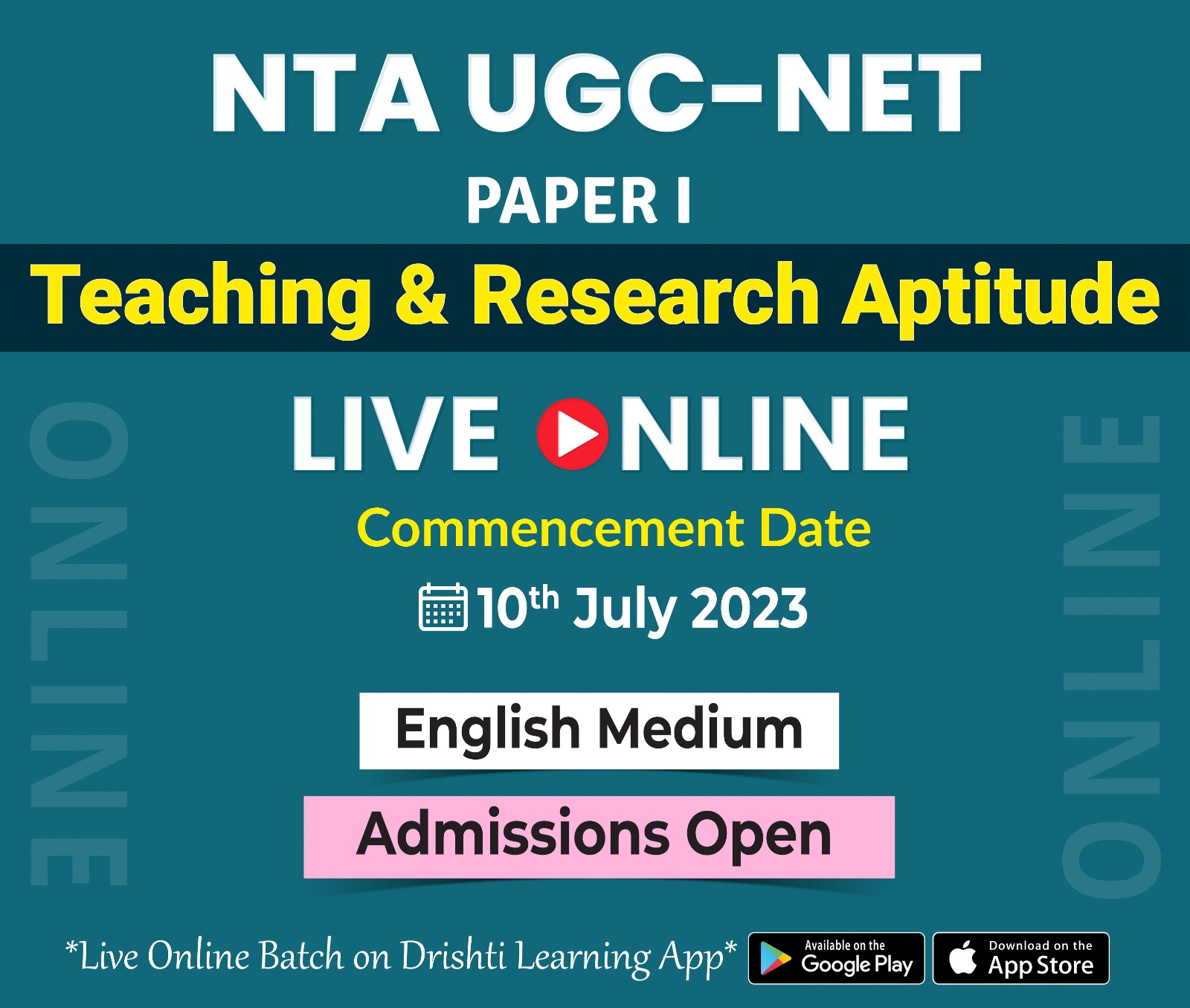
Governance
Government Taps Private Sector to Run Staff Email Service
For Prelims: NICNET Services, National Informatics Centre (NIC)
For Mains: Role of digital transformation in modernizing government communication systems
Why in News?
Recently, the Ministry of Electronics and Information Technology (MeitY) has approved bids from six companies - Larsen & Toubro, Infosys, Softline, Zoho, Railtel, and Rediffmail in response to an RFP (request for proposal) floated in March 2023 for the selection of a Master System Integrator (MSI) for providing email cloud solutions for the Government.
- The government is conducting Pilot Projects to test the efficacy of these alternate email providers.
What are NICNET Services?
- NICNET is a satellite-based nationwide computer-communication network, that is a type of Wide Area Network (WAN).
- It is run by the National Informatics Centre (NIC), which is a part of the MeitY.
- NICNET has institutional linkages across all the Ministries /Departments of the Central Government, State Governments, Union Territories, and District administrations of the country.
- The current NICNET e-mail service, hosts government email addresses ending in @nic.in and @gov.in, is distributed across many mail servers located at various NIC Centres.
What Are the Pilot Projects to Test the Efficacy of Alternate Email Providers?
- Microsoft Office 365: Microsoft is conducting its email testing services on 7,036 email users in the railways.
- Zoho: Zoho, the cloud-based software company, is performing test runs on 6,825 email users in Ministries like MeitY, the Department of Technology, and the NIC itself.
What is the RFP issued by the Digital India Corporation?
- It outlines the requirements and specifications for a robust cloud-based email solution.
- Cloud-based email solution provides email hosting and management on remote servers that are accessed via the internet. Cloud-based email solutions offer a flexible, scalable and cost-effective alternative for businesses and individuals.
- The RFP focuses on data security, privacy, and the use of advanced technologies.
- It plays a pivotal role in involving the private sector in managing government email services.
- The RFP ensures that the email solution is hosted within India's boundaries for data sovereignty and security.
- It emphasizes the use of Artificial Intelligence models to detect phishing and prompt notification of cyber-attacks.
- The RFP is part of the government's initiative to enhance its communication systems and facilitate digital transformation.
Note: Digital India Corporation is a not for profit Company set up by Ministry of Electronics and Information Technology (MeitY), Govt. of India, under Section 8 of Companies Act 2013.
What are the Benefits of Private Sector Involvement in Government Email Services?
- Enhanced Expertise and Resources:
- The government recognized the expertise and resources offered by the private sector in managing communication systems effectively.
- Improved Efficiency and Productivity:
- The government aims to enhance the efficiency and productivity of its internal communication processes by involving private companies while ensuring a robust cybersecurity mechanism and cloud security.
- Digital Transformation:
- The move aligns with the government's agenda of digital transformation and modernizing its communication systems.
- This project aims to migrate nearly 3.3 million government employees registered on NIC to an email service hosted on a secure cloud, providing them with a range of office productivity tools, collaboration features, and services such as video conferencing and chat.
- The move aligns with the government's agenda of digital transformation and modernizing its communication systems.
- Scalability and Flexibility:
- Partnering with private companies allows the government to leverage scalable solutions that can accommodate its large workforce and evolving needs.
- Digital Sovereignty and Security:
- The government emphasizes hosting email services within India's boundaries for data sovereignty and enhanced security. The use of AI models and prompt notification of cyber-attacks contribute to strengthening security measures.

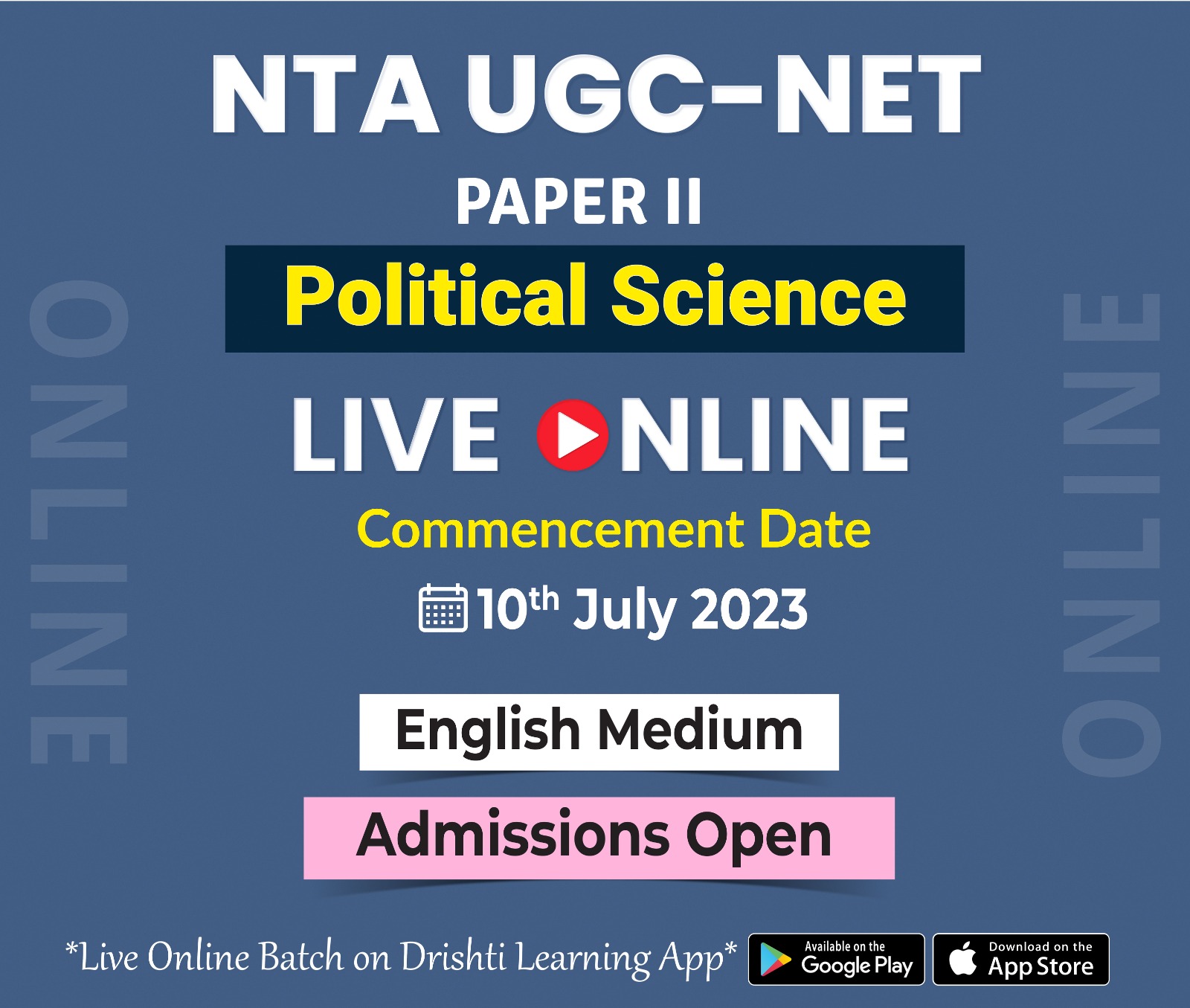
Important Facts For Prelims
Smart Bandage
Why in News?
A recently published study highlights the development of a wearable, wireless, and mechanically flexible "smart bandage" that has the potential to accelerate the healing of chronic wounds.
What is a Smart Bandage?
- About:
- The smart bandage, developed by researchers at the California Institute of Technology (Caltech), integrates biosensors, drug-loaded hydrogels, electrical stimulation modules, and wireless communication.
- It is designed to maintain contact with and adhere to the skin using a soft, stretchable polymer.
- The bandage includes biosensors that monitor wound biomarkers in the exudate, providing real-time information about the wound's status.
- Data collected by the bandage is wirelessly transmitted to a smartphone or tablet for review by healthcare professionals.
- Working Process:
- Biosensors track changes in the chemical composition of wound exudates, providing insights into the healing process.
- Additional sensors monitor pH levels and temperature, offering valuable information about infection and inflammation.
- The bandage includes electrodes that control drug release from a hydrogel layer and stimulate tissue regeneration.
- Wireless transmission of data eliminates the need for bulky equipment and wired connections, increasing convenience and usability.
- Research Findings:
- Electrical stimulation enhanced tissue regeneration in skin cell studies.
- Bandage accurately monitored infection, inflammation, and metabolic statuses in diabetic mice.
- Diabetic rats treated with drugs and electrical stimulation showed faster wound closure and reduced scarring.
- Limitations and Future Directions:
- Biosensors had delayed response due to chemical mixing.
- Biosensor protection and manufacturing scaling need improvement.
- Implications and Challenges:
- Chronic wounds burden healthcare systems, necessitating effective therapies.
- Smart bandage offers continuous monitoring, targeted drug delivery, and reduced hospital visits.
- Affordability and accessibility challenges for lower socio-economic individuals.
- Government initiatives and insurance schemes can facilitate wider availability.
What are Chronic Wounds?
- Chronic wounds are wounds that do not heal within the expected timeframe and exhibit a disordered healing process.
- They are often associated with underlying health conditions such as diabetes, insufficient blood supply, nerve damage, or immune system dysfunction. Chronic wounds can include diabetic ulcers, pressure ulcers, venous ulcers, and non-healing surgical wounds.

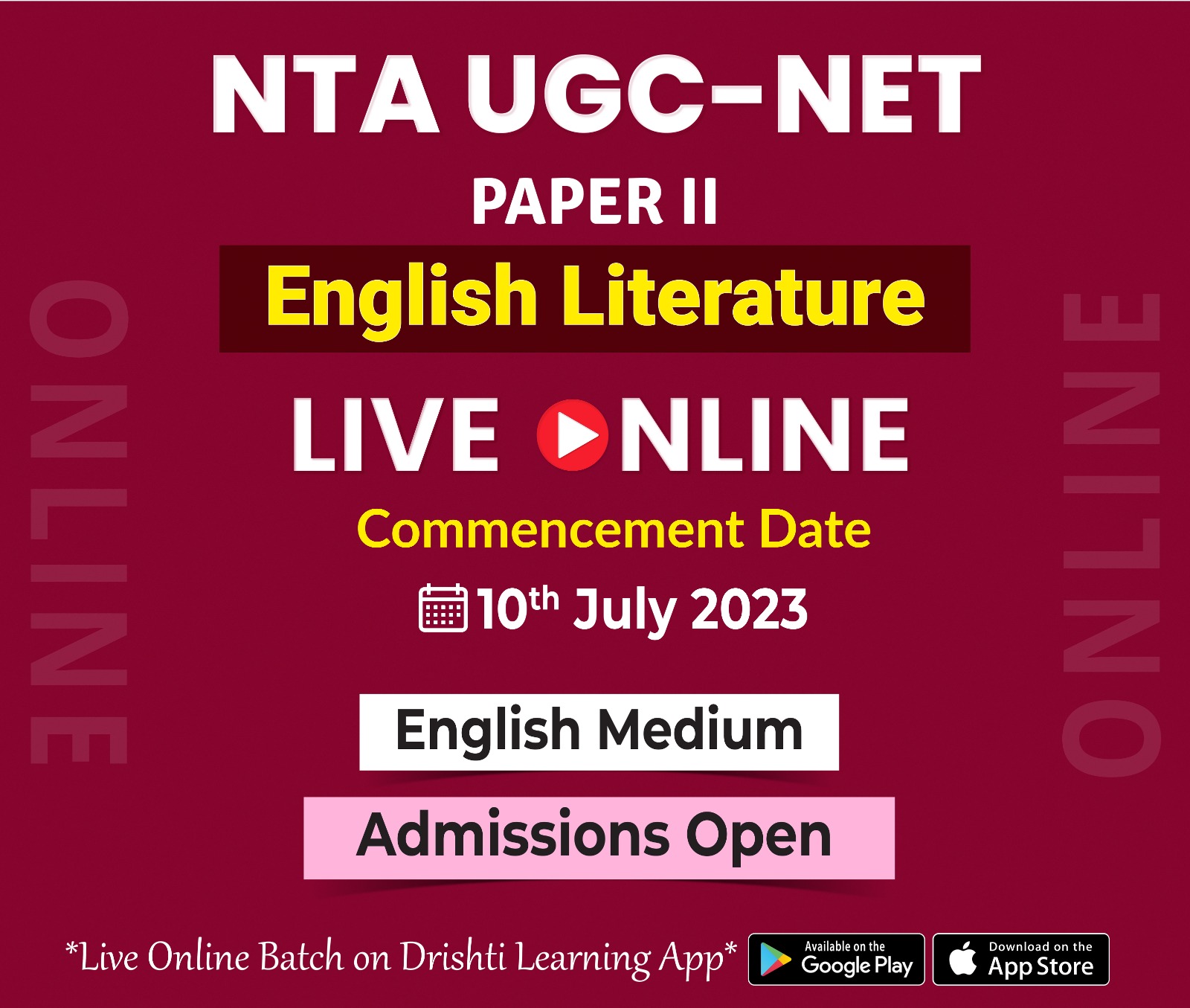
Important Facts For Prelims
Israeli Military Operation in Jenin Refugee Camp
Why In News?
Recently, Israel launched a military operation in the Jenin Refugee Camp in the occupied West Bank, resembling wide-scale operations carried out during the second Palestinian uprising (2000-2005).
- The operation aimed to destroy and confiscate weapons and targeted specific militant groups. It involved around 2,000 soldiers and utilized military drones for strikes.
- The Jenin camp has historically been a stronghold for armed struggle against Israeli occupation and a focal point for violence.
What are the Key Points related to Jenin Refugee Camp?
- Jenin Refugee Camp is a Palestinian refugee camp located in the northern West Bank, specifically in the city of Jenin.
- Established in 1953, the camp was created to accommodate Palestinian refugees who were displaced during the 1948 Arab Israeli war, also known as the Nakba ("catastrophe" in Arabic).
- The camp has also been a site of frequent clashes between Palestinian militants and Israeli forces over the years.
- It gained particular attention during the second Palestinian uprising, also known as the Al-Aqsa Intifada (2000-2005), when it became a stronghold for armed resistance against Israeli occupation.
- Jenin Refugee Camp remains a symbol of the Palestinian refugee issue and the ongoing Israeli-Palestinian conflict.
What are the Other Important Places Linked to Israel Palestine Conflict?
- Al Aqsa Mosque:
- It is one of the holiest structures in the Islamic faith known by Muslims as Haram al-Sharif, or the Noble Sanctuary, and by Jews as the Temple Mount.
- The site is part of the Old City of Jerusalem, sacred to Christians, Jews and Muslims.
- Sheikh Jarrah:
- Sheikh Jarrah is a neighborhood located north of the Old City in East Jerusalem.
- Hundreds of thousands of Palestinians were forced out of their homes when the State of Israel was created in historical Palestine in 1948.
- Twenty-eight of those Palestinian families moved to Sheikh Jarrah in East Jerusalem to settle there.
- Sheikh Jarrah is a neighborhood located north of the Old City in East Jerusalem.
- West Bank:
- West Bank is a landlocked territory in West Asia. It also contains a significant section of the western Dead Sea.
- It was captured by Jordan after the Arab-Israeli War (1948) but Israel snatched it back during the Six-Day War of 1967 and has occupied it ever since.
- The West Bank is sandwiched between Israel and Jordan.
- Gaza Strip:
- The Gaza Strip is located between Israel and Egypt. Israel occupied the strip after 1967, but relinquished control of Gaza City and day-to-day administration in most of the territory during the Oslo peace process.
- In 2005, Israel unilaterally removed Jewish settlements from the territory, though it continues to control international access to it.
- Golan Heights:
- The Golan Heights is a strategic plateau that Israel captured from Syria in the 1967 war. Israel effectively annexed the territory in 1981.
- In 2017, the USA officially recognized Jerusalem and Golan Heights a part of Israel.
UPSC Civil Services Examination Previous Year Question (PYQ):
Q1. Consider the following statements: (2023)
Statement-I: Israel has established diplomatic relations with some Arab States.
Statement-II: The ‘Arab Peace Initiative’ mediated by Saudi Arabia was signed by Israel and Arab League.
Which one of the following is correct in respect of the above statements?
(a) Both Statement-I and Statement-II are correct, and Statement-II is the correct explanation for Statement-I
(b) Both Statement-I and Statement-II are correct, and Statement-II is not the correct explanation for Statement-I
(c) Statement-I is correct, but Statement-II is incorrect
(d) Statement-I is incorrect, but Statement-II is correct
Ans: (c)
Q2. The term “two-state solution” is sometimes mentioned in the news in the context of the affairs of (2018)
(a) China
(b) Israel
(c) Iraq
(d) Yemen
Ans: (b)
Q3. Yom Kippur War was fought between which sides/countries? (2008)
(a) Turkey and Greece
(b) Serbs and Croats
(c) Israel, and Arab countries led by Egypt and Syria
(d) Iran and Iraq
Ans: (c)


Important Facts For Prelims
CMV and ToMV Virus
Why in News?
Tomato growers in Maharashtra attribute crop decline to the Cucumber Mosaic Virus (CMV), while growers in Karnataka and other South Indian states blame the Tomato Mosaic Virus (ToMV) for their crop losses.
- Over the last three years, growers of tomato have complained of increased infestation with these two viruses, leading to partial to complete crop losses.
What are ToMV and CMV?
- ToMV:
- About:
- ToMV belongs to the Virgaviridae family and is closely related to the Tobacco Mosaic Virus (TMV). It infects tomato, tobacco, peppers, and certain ornamental plants.
- It was first identified in tomato in 1935.
- Transmission:
- ToMV mainly spreads through infected seeds, saplings, agricultural tools, and human contact.
- It can also be transmitted by some insect vectors, such as thrips and whiteflies.
- Effects on Crops:
- ToMV causes green mottling and yellowing of leaves, which often appear as blisters or fern-like patterns.
- The leaves may also curl downwards or upwards and become distorted.
- Younger plants are dwarfed, and fruit setting is affected.
- Control Measures:
- Emphasize biosafety standards in nurseries and implementing compulsory seed treatment.
- Farmers should inspect saplings before planting and discard any infected material.
- About:
- CMV:
- About:
- CMV belongs to the Bromoviridae family and is one of the most widespread plant viruses. It has a broader host range, affecting cucumber, melon, eggplant, tomato, carrot, lettuce, celery, cucurbits, and some ornamentals.
- It was first identified in cucumber in 1934.
- Transmission:
- CMV mainly spreads through aphids, which are sap-sucking insects that can acquire and transmit the virus within minutes.
- It can also be transmitted by seeds, mechanical inoculation, and grafting.
- CMV mainly spreads through aphids, which are sap-sucking insects that can acquire and transmit the virus within minutes.
- Effect on Crops:
- Distorts leaves, primarily at the top and bottom while leaving the middle relatively unaffected.
- In cucumber, it causes a mosaic-like pattern of yellow and green spots.
- Affects fruit formation and leads to stunting and reduced production.
- Control Measures:
- Focus on preventing aphids by using quick-acting insecticides or mineral oils.
- Care should be taken to avoid aphid migration and spread of the virus to other fields.
- About:
- Similarity:
- Both viruses have a single-stranded RNA genome that is encapsidated in a rod-shaped protein coat. Both viruses enter the plant cells through wounds or natural openings and replicate in the cytoplasm.
- They then move systemically throughout the plant via the phloem.
- Also, Both viruses can cause almost 100% crop loss unless properly treated on time.
- Both viruses have a single-stranded RNA genome that is encapsidated in a rod-shaped protein coat. Both viruses enter the plant cells through wounds or natural openings and replicate in the cytoplasm.
Note:
- Phloem is a complex tissue found in vascular plants, responsible for the transport of organic nutrients, primarily sugars, throughout the plant.
- Cytoplasm is the gel-like substance that fills the interior of cells. It is a semifluid medium composed of water, salts, proteins, and other molecules.
- RNA is a genetic material composed of ribonucleic acid (RNA). It carries genetic information in the form of single-stranded nucleotide sequences.


Rapid Fire
Rapid Fire Current Affairs
India-Singapore Extend MoU on Personnel Management and Public Administration
The Department of Administrative Reforms and Public Grievances, Ministry of Personnel, Public Grievances and Pensions, Government of India, and The Public Service Division of the Republic of Singapore has signed a Protocol Document, extending the current Memorandum of Understanding (MoU) which was signed in 2018 on Cooperation in the field of Personnel Management and Public Administration for five more years until 2028.
This extended MoU aims to enhance the partnership between the two countries by fostering cooperation among their Public Service officers. The areas of collaboration include Administrative Reforms & Public Sector Transformation, Public Service Delivery, Leadership and Talent Development, E-Governance, Capacity Building, and Training.
Read more: India-Singapore Ties
Methane-Rich Groundwater Springs in the Arctic
Climate change is causing the retreat of glaciers in the Arctic, revealing methane-rich groundwater springs, according to a study published in Nature Geoscience. These springs, found in Svalbard, a Norwegian archipelago in the Arctic, are releasing over 2,000 tonnes of methane annually, equivalent to 10% of Norway's oil and gas industry emissions. The high methane concentrations in the water, detected year-round, suggest the presence of trapped methane under glaciers. These springs are not part of the global methane budget. The global methane budget estimates the amount of methane released through sources and captured through sinks.
Groundwater springs are natural occurrences where water from an underground aquifer emerges onto the Earth's surface. They are typically formed when pressure builds up within the aquifer, forcing water to flow through fractures or openings in the rocks.
Read more: Methane Emissions, Phase Out Methane Emissions By 2030
Zaporizhzhya Nuclear Plant: Lower Risks Compared to Chernobyl
The Zaporizhzhya Nuclear Power Plant (NPP) in Ukraine, currently under Russian control, faces safety threats due to the ongoing conflict. However, a recent report by the Bellona Foundation highlights that risks and potential consequences at Zaporizhzhya NPP are not expected to be as severe as Chernobyl.
Zaporizhzhya is the largest nuclear power plant in Europe. It accounts for about 40% of the total electricity generated by all the Ukrainian NPPs and one-fifth of Ukraine’s annual electricity production.
Read more: Zaporizhzhya Nuclear Power Plant
Cheetahs to be Relocated from Kuno National Park to Gandhi Sagar Sanctuary in Madhya Pradesh
In an effort to ensure the preservation and expansion of the cheetah population in India, officials have announced plans to relocate some African cheetahs from Kuno National Park (KNP) in Madhya Pradesh to the Gandhi Sagar Sanctuary within the same state.
The wildlife warden of KNP stated that the relocation would be carried out in strict adherence to the Cheetah Action Plan, which involves identifying suitable habitats for the cheetahs.
The decision to relocate the cheetahs comes after the Supreme Court's directive to distribute cheetahs across a broader geographic range, following the deaths of three cheetahs within a 45-day period earlier this year.
Read more: African cheetahs, Cheetah Action Plan.



